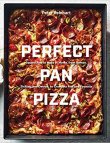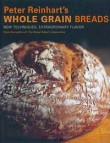Peter’s Blog, Sept. 15th, Cold Fermentation
He’s raised an interesting question: does long, cold, overnight fermentation create a flavor that would universally be considered superior; that is, an inarguable benefit? To answer this, I think, requires more than a simple yes or no, but an explanation as to what happens during the fermentation stage that would lead to the opinion that this is a way to improve flavor. We’ve discussed this here in the past, though in an abbreviated manner, so let me draw it out more completely and, hopefully, address Scott’s question at the same time.
My belief (and remember, this is just my opinion — no one owns the whole truth in these matters) is that the key to the value of long fermentation is the enzyme activity, in particular the alpha-amylase and beta-amylase action that slowly releases glucose, maltose, and other sugars from their starchy chains in the flour. This takes time, anywhere from 6 to 12 hours minimum, but it is not a biological fermentation since enzymes are not alive, they are simply part of the grain (protein fragments, but not living organisms, if I understand the chemistry of them properly, but then I’m no chemist). The process of sugar break-out from the starch is slower at colder temperatures but is not subject to the same rules as yeast and bacteria (which essentially go nearly dormant when they get cooler than 40 degrees F.). Anyway, pizza makers have known for a long time, whether by accident or intentionality, that their dough balls are better tasting and more beautiful to look at when used the following day (or even over a number of days, within reason) than if used on the same day in a fast rising method. It is not only because the fermentation is better in the slow method but, I believe, because more natural sugar has been evoked from grain by the enzymes and that improves both color and flavor, as well as providing new, ongoing food for the yeast and bacterial fermentation (so, in a way, it does elicit more fermentation flavor as well as releasing sugar). Bottom line: yes, Scott, I do believe long, cold fermentation improves flavor but, I have to say this too, it is not the only way to release flavor — that is, it is time more than coldness that is the key.
I say this because, as we discussed in the long comment thread a few weeks ago, Philippe Gosselin (and I’m sure others) uses a method that doesn’t require any yeast during the overnight period and, more importantly, pizza masters like Chris Bianco are able to achieve amazing flavor and texture by making their dough on the same day, not using any refrigeration. But in Bianco’s case, and others who can pull it off, the dough is made early enough in the day to allow the enzyme activity to occur without over-fermenting the dough by using a smaller amount of yeast. In other words, the “baking triangle” consisting of time, temperature and ingredients can be manipulated in many ways to achieve great results. Some methods and formulas might, for example, use a pre-ferment like a biga, poolish, or pate fermentee’ to add enzyme-evoked flavor in a shorter period of time.
So, to summarize, Scott123 is correct in asserting that long, cold fermentation achieves superior results to short, fast fermentation but let’s not forget the possibility of long, room temperature fermentation too, or the use of pre-ferments to shorten fermentation time (I won’t even touch the matter of commercial dough conditioners that spike the dough with added enzymes to speed things along — that’s another can of worms but one worth visiting in the future). If I’m not mistaken, Jim Lahey uses the room temperature method in his so-called “NY Times French Bread” method (and I believe also in his pizza dough — BTW, I think we should stop calling it the NY Times method and let Jim have it named after him, the Lahey method — I’m okay with that since he’s the one who first brought it to light and Jim is a good guy!). The fact that his French Bread dough sits overnight before going into a hot Dutch oven is for convenience more than because it is “overnight” — you could mix it in the morning and bake it at night just as easily; it is time, that very critical point on the baking triangle, that affects the flavor, as long as it is properly balanced by the other two corresponding points (ingredients = small amount of yeast; temperature = either cold or, possibly, ambient room temperature). For a pizzeria, though, it makes sense to work a day or two ahead for any number of reasons and, from what I observed at Pizzeria Bianco, it may simply be a matter of lack of space and refrigeration that necessitated the ambient method rather than a philosophical or anti-cold fermentation dough method. That is, we can almost always make the situation work to our advantage if we keep the three points on the “baking triangle” in the proper balance.
Okay, that’s my take on it — what do you all think?
Recent Articles by Peter Reinhart
- Peter Scott Ruben: Why Frank Sinatra is the true “Chairman of the Board,” and the Greatest of the Greats
- Elizabeth Brasch, Mellow Mushroom’s Has a Vision
- Nipun Sharma: Pizza’s A-I Robotics Future is Now
- Maui Pizza with Chef Jeff Scheer of Restaurant Marlow
- The Pizza Yodi’s Are Back –John Arena and Brian Spangler are in the House!
- Arthur Bovino and Alfred Schulz and Their Pizza Pod Party
Add Comment
You must be logged in to post a comment.










There is so much going on in dough at the same time that essentially your dough handling is akin to making a flavor by process. There are enzymatic processes, there are yeast fermntations, lactic acid fermention and not to mention full gluten development. Most pizza dough I have made will not windowpane straight from the mixer…2 hrs later after bulk fermentation the dough will be a different animal…then 72 hrs later even more different.
One of the few things I do know is that LAB are mesophillic bacteria and they don’t slow down so much in the retarder. Yeast on the other hand slow down alot. and enzymes slow down as well. If you ever had dougth overproof its looses all its structure.
In the end, in the end I have to say that many(not all, but many) VPN certified places I have been too have had great pie…but NOT legendary Pie because the pizza purity laws control the recipe and the process. Hydration effects all of these biochemical processes and VPN dough is slaved to be ~55% hydration and RT fermented…therefore yeast activity is good and certain strains of LAB cannot compete for available glucose/maltose. Acetobacter is one that I know of.
Those of you that bake bread will find that the sour taste of a good baugette is enhanced by the high hydration dough and typical high hydration starters and that Italian breads made from a Biga and lower hydration taste different.
Again hydration being yet another variable.
And lets not forget malliard browning….which delivers the final profile to the dough.
In the end…the baker can manipulate the recipe to fit his shop and deliver the signature.
I have made good pizza with RT fermented dough…but for my taste…the dough I make via indirect method after 72 in the retarder…is Brilliant!
For me RT dough is kinda monochromatic..it lacks the lactic acid tang that seems to complement good tomatoe product and high quality Mootz. JMHO
Joe A – I don’t get it. You seem to be claiming that the LAB in sourdough does not reduce its growth rate as temperature declines where as the yeast and enzyme activity does slow down.
I believe that all of the rate-limiting processes of cell metabolism are exponential functions of temperature.
If you think otherwise, perhaps you could provide some coaching so that I can better understand why the yeast and LAB behave differently.
Michael Ganzle’s paper suggests that at least the species of LAB and yeast that he studied are both exponential in temperature response and very closely matched in growth rate as a function of temperature.
Doc:
You are correct….both microorganisms slow down….but the LAB being mesophillic bacteria and not yeast which are fungi will behave differently as the temperature goes down, The LAB have more activity at cold temperatures than the yeast and in typical natural levain the LAB outnumber the Wild Yeast by 2 oirders of magnitude…net net you get less yeast and more LAB activity as a result.
Most chemical reactions are exponential but if you look at a typical Arrhenius Plot the Energy of activation will dictate how low is too low for the kinetics to be significant and where it drops off the mountain.
So what I am saying is that these two organisms have a temperature range they behave optimally in and that the LAB don’t get affected by the cold as much.
Sterile…Thats why they always advise not eating raw dough in the spec sheets.